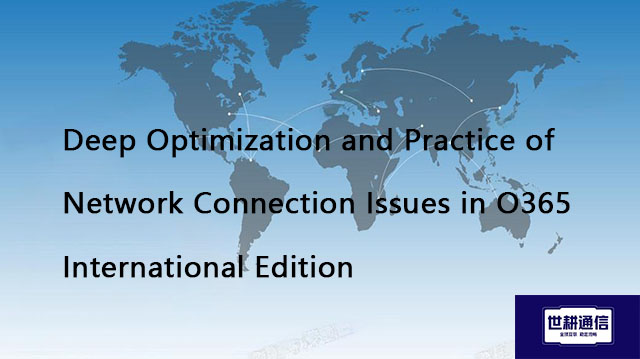Deep Optimization and Practice of Network Connection Issues in O365 International Edition??? Solution//Global IPLC service provider of Shigeng Communication
一、In the global wave of digital transformation, Microsoft 365 (formerly Office 365) has become the core productivity platform for enterprises. However, when domestic users access the international version of the service, delays of up to 150ms and packet loss rates of 5% -10% often lead to Teams meeting lag, OneDrive synchronization failure, and slow Outlook loading, seriously affecting the efficiency of cross-border enterprise collaboration. Microsoft has explicitly stated that the "last mile" network congestion between Chinese and global servers is the main cause, and recommends optimizing cross-border transmission performance through dedicated network architecture.
1. Root cause of the problem: performance bottleneck analysis of cross-border access
Physical distance and network redirection
Office 365 International data centers are mainly located in Singapore, Japan, or Europe and America. The access of domestic users needs to pass through multiple international gateways, and the delay increases by 15-30ms for each additional hop. Uncontrollable factors of the public Internet (such as peak congestion and route turbulence) further lead to a surge in packet loss rate, which has a devastating impact on real-time applications such as the Teams conference.
Protocol layer restrictions
The efficiency of TCP protocol drops sharply in long-distance transmission: the retransmission mechanism after packet loss leads to an exponential decrease in throughput. Tests have shown that when the delay is>100ms and the packet loss rate is>2%, the file upload speed is reduced by more than 60%.
Bandwidth competition and QoS deficiency
Non critical traffic within the enterprise, such as video streaming and software updates, squeezes bandwidth, and traditional routers cannot recognize the priority of Office 365 traffic, resulting in delayed critical business data.
2. SD-WAN: Building the Core Engine for Targeted Acceleration
SD-WAN reconstructs cross-border connection paths through software defined network technology, becoming an optimization solution recommended by Microsoft.
Key technology implementation
Intelligent path selection
Deploy SD-WAN CPE devices at the edge to automatically detect Office 365 traffic (through IP address libraries or deep packet inspection). The traffic is pulled to the nearest global POP nodes (such as access points in Beijing and Shanghai), and directly connected to overseas Microsoft data centers through private backbone networks to avoid public Internet congestion nodes.
Case: After deployment by a financial enterprise, the delay of Teams from Hong Kong to Singapore decreased from 142ms to 89ms, and the jitter was reduced by 90%.
Application layer optimization technology
TCP Acceleration: Refactoring the protocol stack, expanding the window size, reducing the number of confirmations, and improving long-distance transmission efficiency
Data compression and duplicate deletion: real-time compression of document and email body, saving 30% -50% bandwidth
Forward Error Correction (FEC): Adding redundant data packets to enable the link to achieve 0 retransmissions even at a 5% packet loss rate
3. Enhancement plan: Multi dimensional collaborative optimization
1. Backbone network dedicated line integration
MPLS hybrid networking: MPLS ensures SLA (latency<50ms, packet loss rate<0.1%) between core nodes, and branches access through IPSec encryption
Cloud dedicated line access to Azure FHIR: bypass the public network and directly access Microsoft Cloud, suitable for large enterprises
2. edge computing optimization
Local cache server: Cache SharePoint templates and Office update packages to reduce cross-border duplicate transfers
UDP protocol conversion: Convert Teams audio and video streams to QUIC protocol to reduce real-time business latency sensitivity
3. Terminal strategy optimization
Client configuration update: Disable non essential plugins, set registry parameters to optimize TCP windows
DNS intelligent resolution: using Anycast DNS to ensure user resolution to the nearest service endpoint
4. Implementation Roadmap: Four Steps to Build High Performance Access
baseline assessment
Use Network Assessment Tool to measure existing links: latency, jitter, packet loss rate, and identify bottleneck points.
architecture design
Choose an SD-WAN vendor that supports SaaS acceleration (requires verification of Office 365 optimization capabilities)
Plan the location of POP access points (domestic: Beijing, Shanghai, Guangzhou; overseas: Singapore, Tokyo)
5. Enterprise Practice: From Crisis to Efficiency Leap
A multinational manufacturing company once experienced three daily interruptions in cross-border production research conferences due to O365 lag. After optimization:
Teams latency reduced from 122ms to 67ms, MOS score increased to 4.1
The speed of accessing SharePoint in the Shanghai office has increased from 1.2MB/s to 8.5MB/s
Annual IT failure work orders reduced by 40%, estimated to recover over $250000 in lost productivity
Architect insight: Optimization is not only about technological upgrades, but also about ensuring business continuity. In the future, it can evolve towards SASE (Secure Access Service Edge), integrating zero trust security and global acceleration.
conclusion
Office 365 International Edition acceleration requires a "global optimization" perspective: from the physical layer (dedicated line+POP node) to the protocol layer (TCP optimization), and then to the application layer (QoS policy). As the core hub, SD-WAN can improve the efficiency of cross-border access by 3-5 times with edge computing and terminal tuning. With the deepening of enterprise globalization, building a high resilience network architecture has been upgraded from an "optional solution" to a "survival necessity" and is also a key footnote to digital competitiveness.

二、Shigeng Communication Global Office Network Products:
The global office network product of Shigeng Communication is a high-quality product developed by the company for Chinese and foreign enterprise customers to access the application data transmission internet of overseas enterprises by making full use of its own network coverage and network management advantages.
Features of Global Application Network Products for Multinational Enterprises:
1. Quickly access global Internet cloud platform resources
2. Stable and low latency global cloud based video conferencing
3. Convenient and fast use of Internet resource sharing cloud platform (OA/ERP/cloud storage and other applications
Product tariff:
Global office network expenses | Monthly rent payment/yuan | Annual payment/yuan | Remarks |
Quality Package 1 | 1000 | 10800 | Free testing experience for 7 days |
Quality Package 2 | 1500 | 14400 | Free testing experience for 7 days |
Dedicated line package | 2400 | 19200 | Free testing experience for 7 days |







